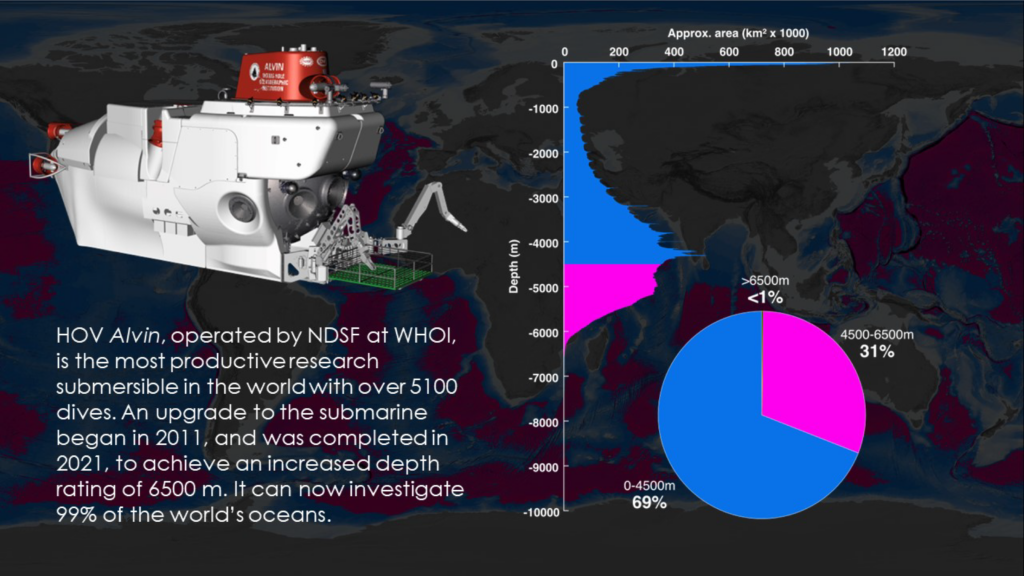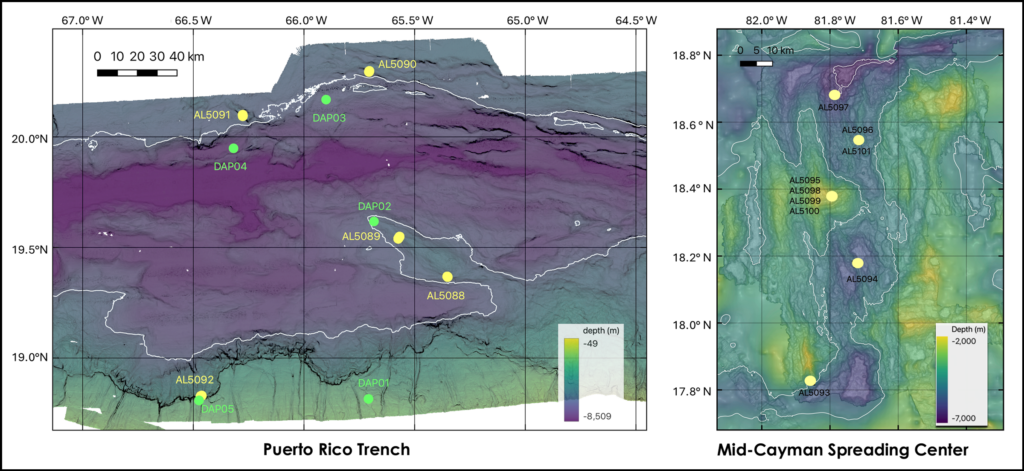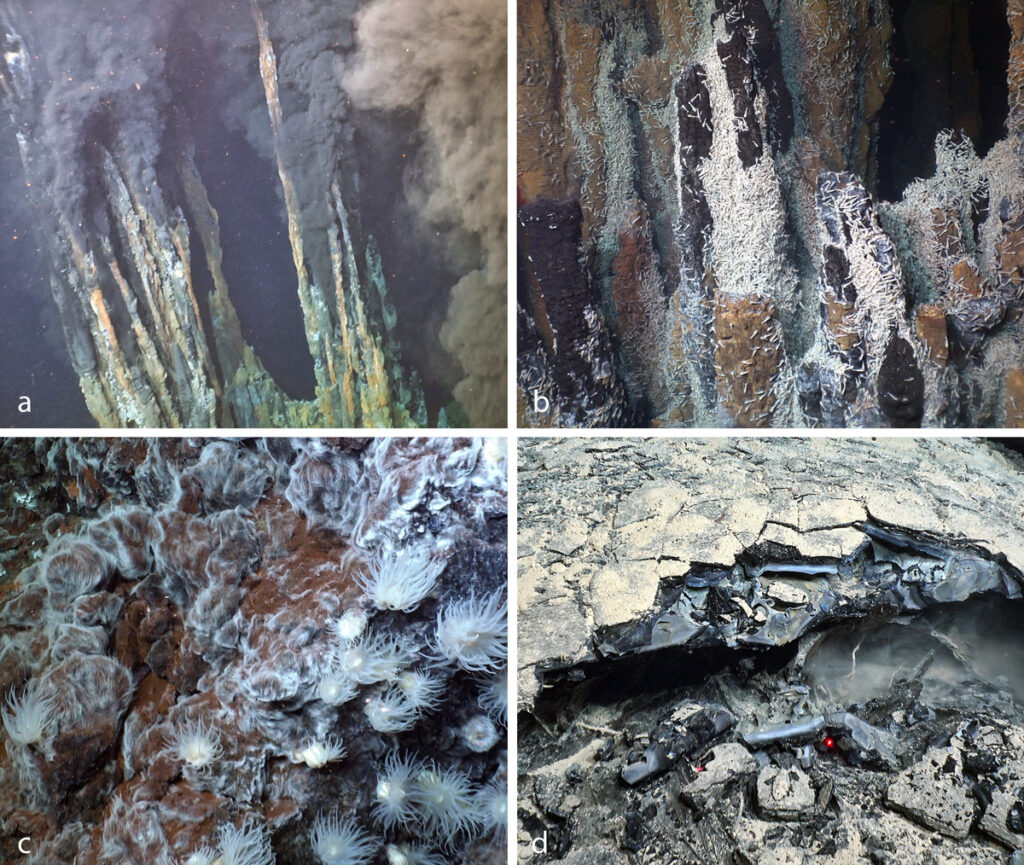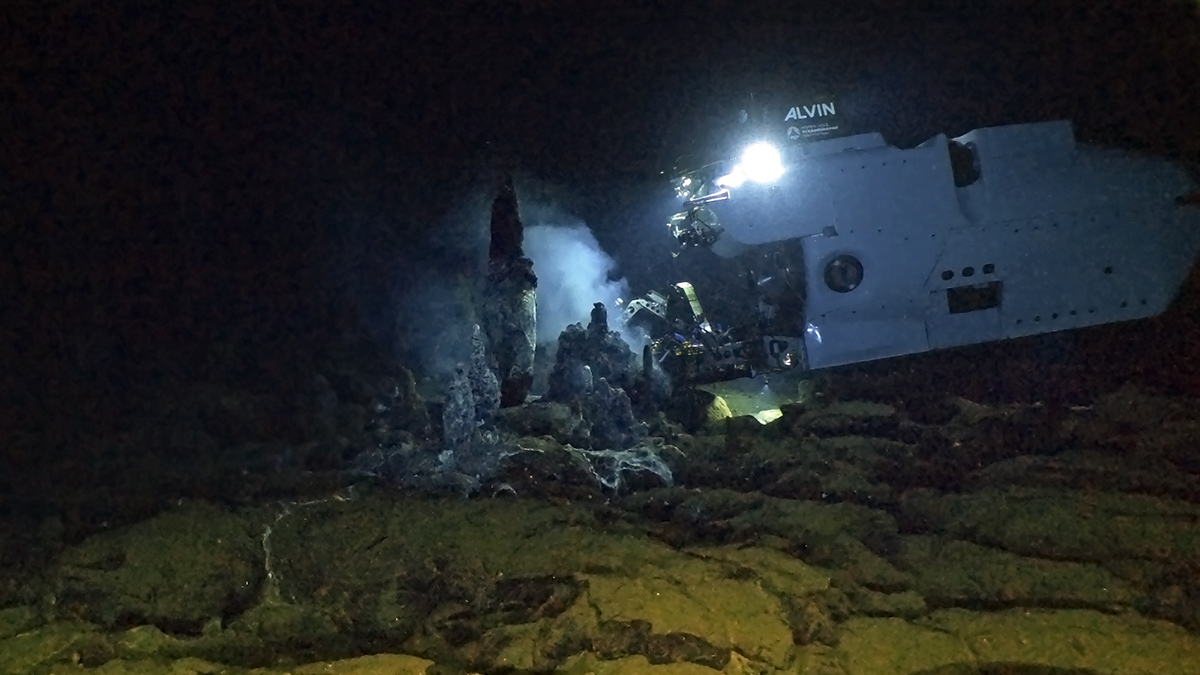The deepest regions of Earth’s oceans, known as the abyssal and hadal zones, lie at least as far under the water’s surface as Mount Rainier’s peak rises above the land surface. These great depths of 4,000 or more meters make up one of Earth’s least explored frontiers and are home to some of its most extreme environments and habitats.
The conditions in these regions—immense pressures, cold temperatures, and the total lack of sunlight—shape the physical, chemical, and geological phenomena that occur there in ways both predictable and surprising [e.g., Marlow et al., 2021]. They also support unique life-forms that—far removed from the sunlit world above—thrive on alternative energy sources such as hydrothermal vents, seeps, and whale falls.
Remotely operated and autonomous vehicles offer valuable access to these regions, but there is no substitute for direct human observation.
This part of the ocean remains largely unexplored because of the technical challenges of reaching such depths. However, potential discoveries within abyssal and hadal regions—such as dark oxygen, critical mineral resources, pressure-adapted extremophilic organisms, distinct ecosystems, archaeological sites (e.g., submerged human artifacts, including shipwrecks), and otherwise unknown landscapes—reinforce their allure. Remotely operated and autonomous vehicles offer valuable access to these regions, but there is no substitute for direct human observation: The situational awareness and targeted, delicate sampling that human-occupied vehicles (HOVs) enable are unique capabilities.
Yet the small number of vehicles capable of reaching abyssal and hadal depths—and the even smaller subset that can safely carry humans—limits the ability to explore them.
A key tool for this exploration is the deep submergence vehicle Alvin, the world’s longest-operating and most productive human-occupied deep-sea submersible, with more than 5,000 dives completed over 60 years of operation. Alvin recently underwent a significant upgrade, allowing it to reach depths of up to 6,500 meters—surpassing its previous limit of 4,500 meters.

The upgrade and a capstone science verification expedition (SVE) represent more than a decade of planning, scientific and engineering input, and technological development that have opened new possibilities for deep-sea research. With Alvin, researchers now have access to roughly 99% of the ocean floor (Figure 1), enabling in-person observations and data collection in regions that were previously unreachable by the submersible.
Exploring the Deep Ocean Directly
Direct exploration is crucial for understanding deep-ocean environments. Pilots and observers inside an HOV can see the area around them, intuitively perceive distances, and feel the movement of the thrusters and robotic arms when they collect samples. These sensory inputs help them understand spatial relationships among features as well as water currents and the condition of specimens as they are being collected.
In addition, because a human-occupied submersible is not connected to a surface ship by a cable, it is a versatile and nimble exploration tool. An HOV can change direction more quickly than a remotely operated vehicle, without requiring a ship move, and it can explore steeper, more complex areas without encountering the constraints of a tether and a surface vessel, albeit usually with shorter dive times.
Such exploration is especially needed, for example, to provide baseline information that allows us to evaluate whether—and, if so, how—human-induced global changes are affecting deep ecosystems at different depths. Such effects are already pronounced in most ocean environments closer to the surface.
Alvin has long been at the forefront of deep-sea exploration.
Alvin is owned by the U.S. Navy and certified under the Navy’s Submarine Safety Program (SUBSAFE) protocol but is part of the National Science Foundation’s National Deep Submergence Facility (NDSF) hosted at the Woods Hole Oceanographic Institution (WHOI). Operated by WHOI since its commissioning in 1964 and used by many research organizations, Alvin has long been at the forefront of deep-sea exploration. It can conduct a variety of logistical and scientific tasks, notably, transporting observers to study sites, conducting mapping and photographic surveys, and collecting samples using its robotic arms.
Throughout its lifetime, Alvin has undergone numerous upgrades to remain a state-of-the-art research platform. The most recent upgrade included outfitting it with a new, larger personnel sphere with better ergonomics and improved visibility, as well as improved thrusters and a more advanced command-and-control system. New high-definition imaging systems and faster data acquisition capabilities were also installed, as were enhanced inertial navigation capabilities enabling very accurate tracking from the surface to seafloor, even at great depth, and a new science interface that enables rapid integration of routine and novel sensors for in-sub viewing.
The 2022 Science Verification Expedition
In summer 2022, a diverse team of scientists—led in part by researchers from WHOI and the University of Rhode Island Graduate School of Oceanography (URI-GSO)—put Alvin and its upgraded systems to the test in real-world conditions during its first SVE following the upgrade [Soule et al., 2022]. Team members represented a wide range of disciplines, career stages, and personal backgrounds, and the expedition included a major milestone in U.S. deep-sea science: Alvin’s first dives below 6,000 meters.
All told, the expedition involved six successful dives in the Puerto Rico Trench to nearly 6,400-meter depth and nine along the Mid-Cayman Rise to nearly 6,100-meter depth (Figure 2). These areas, chosen for their extreme depths and diverse conditions, provided rigorous proving grounds for Alvin’s new systems and offered opportunities to study underexplored regions.
During the dives, scientists explored various geological features, including fault lines, landslides, outcrops of ancient oceanic crust, young volcanic features, and active hydrothermal vent systems. The crew also deployed complementary tools, such as a CTD (conductivity, temperature, depth) profiler, as well as an autonomous sampling lander [Muir et al., 2021] that enhanced Alvin’s observational and sampling capabilities down to 8,000-meter depth.
The 2022 Science Verification Expedition (SVE) yielded observations that contribute to our understanding of Earth’s geological history and processes that shape the ocean floor.
The 2022 expedition yielded several significant scientific observations that have contributed to our understanding of Earth’s geological history and processes that shape the ocean floor. On the Mid-Cayman Rise, researchers aboard Alvin discovered the world’s deepest-known very young (<1–2 decades) submarine volcanic eruption site at 6,000 meters deep [Rubin et al., 2023], an important finding for understanding the effect of high ambient pressure and low temperature on eruption mechanisms.
These researchers also characterized high-grade metamorphic rocks in multiple locations and collected samples at the Von Damm and Beebe active hydrothermal vents [German et al., 2010], which have distinct faunal communities (Figure 3). In addition, the science team recovered the first samples of the active microbial communities living within the vent chimneys, offering insights into life in these extreme environments.

In the Puerto Rico Trench, Alvin’s dives uncovered well-preserved geological structures on steep rock faces, including samples of intrusive oceanic crust [e.g., Rubin et al., 2022] thought to be as much as 100 million years old [Klein et al., 2017]. The site is well suited for systematic follow-on studies of spatiotemporal variations that occur during crustal accretion and alteration at the slow-spreading Mid-Atlantic Ridge. The team also documented behavioral adaptations of deep-dwelling isopods in response to the recent appearance of Sargassum in the Caribbean Sea [Peoples et al., 2024], a remarkable adaptation in the deep ocean to a modern ecological change in the surface waters.
The scientists and Alvin operations team of pilots and engineers on the SVE, over the course of these dives, confirmed the upgraded Alvin’s readiness for abyssal and hadal explorations. Indeed, the submersible’s new capabilities, including enhanced imaging, improved maneuverability, and upgraded navigational tracking, proved essential for the success of the mission.
Since the SVE, Alvin has returned to its regular operational cadence, completing more than 100 dives per year.
Since the SVE, Alvin has returned to its regular operational cadence, completing more than 100 dives per year. These dives have included expeditions back to long-term study sites on the East Pacific Rise—where researchers, aided by the autonomous underwater vehicle Sentry, discovered a new off-axis hydrothermal vent site (D. Fornari, personal communication, 2024)—and in the Guaymas Basin, where scientists found dramatically changed hydrothermal venting at a previously known site (M. Joye, personal communication, 2024). A subsequent series of deep science dives in 2024 reached nearly 5,000 meters in the Aleutian Trench, where polychaete-populated seeps were observed to provide habitat for a host of organisms such as hydroids, foraminifera, bacteria, and folliculinids, including possibly new species discoveries (L. Levin, personal communication, 2024).
Alvin’s Legacy and Future
The deep ocean is a place where high hydrostatic pressure influences biological adaptation, geological processes like volcanism, and chemical phenomena such as mineral and ore formation. Throughout its history, Alvin—the most active research submersible in the world and the only U.S. HOV capable of reaching such extreme depths—has contributed to numerous scientific discoveries related to these processes, as well as to explorations of shipwrecks and unknown deep-sea environs.

Alvin’s notable contributions to deep-sea exploration include, among many others, the first discoveries of submarine hydrothermal vents (on the Galapagos Spreading Center in 1977) and black smokers (at 21°N on the East Pacific Rise in 1979), the discovery of methane seeps along the Florida Escarpment in 1984, Bob Ballard’s famous 1986 dive to the Titanic, and the first exploration of the unique Lost City hydrothermal field in 2000.
Alvin has also supported U.S. leadership in deep-ocean exploration and motivated the work of more than 14,000 personnel. Continuing through the SVE in 2022, it has been a major part of each of our own dive histories, for example, contributing indelibly to our research and careers.
The continuing focus on inclusivity in future expeditions will help to foster a welcoming environment for the next generation of researchers using Alvin.
The SVE didn’t involve just established scientists, however. As part of an emphasis on equity, diversity, and inclusion within the scientific community, it also included 11 early-career scientists, most of whom were diving in Alvin for the first time. These scientists offered their expertise in geology, microbiology, biology, hydrothermal activity, and resource mapping, and they hailed from oceanographic institutions, large research universities, and smaller teaching colleges, as well as from the Cayman Islands government. The continuing focus on inclusivity in future expeditions will help to foster a welcoming environment for the next generation of researchers using Alvin to expand our understanding of deep-sea biological, geological, and chemical processes.
Alvin’s upgraded capabilities will offer these scientists opportunities to study such processes in greater detail, contributing to knowledge of how life and Earth itself have evolved under extreme conditions. They will also help to provide vital understanding and insights into how human activities are increasingly affecting environments, including deep-ocean ecosystems, supporting comprehensive assessments of global change and how we might manage these regions. As we continue to push the boundaries of human exploration ever deeper in the ocean, Alvin remains a critical tool and a symbol of enduring curiosity and commitment to understanding the world beneath the waves.
Acknowledgments
Alvin is a U.S. Navy–owned asset certified under the Navy’s SUBSAFE protocol with support from the Naval Sea Systems Command (NAVSEA). The recent Alvin upgrade was supported primarily by the National Science Foundation with additional support from the Office of Naval Research. K.H.R. is the associate dean of research at URI-GSO and has completed more than 30 HOV dives. A.P.M.M. is an associate scientist at WHOI and the current chief scientist of deep submergence at NDSF. S.A.S. is a professor of oceanography at URI-GSO, director of the Ocean Exploration Cooperative Institute, and former NDSF chief scientist.
References
German, C. R., et al. (2010), Diverse styles of submarine venting on the ultraslow spreading Mid-Cayman Rise, Proc. Natl. Acad. Sci. U. S. A., 107(32), 14,020—14,025, https://doi.org/10.1073/pnas.1009205107.
Klein, F., et al. (2017), Mid-ocean ridge serpentinite in the Puerto Rico Trench: From seafloor spreading to subduction, J. Petrol., 58(9), 1,729–1,754, https://doi.org/10.1093/petrology/egx071.
Marlow, J. J., et al. (2021), New opportunities and untapped scientific potential in the abyssal ocean, Front. Mar. Sci., 8, 798943, https://doi.org/10.3389/fmars.2021.798943.
Muir, L., et al. (2021), The Deep Autonomous Profiler (DAP), a platform for hadal profiling and water sample collection, J. Atmos. Oceanic Technol., 38(10), 1,833–1,845.
Peoples, L. M., et al. (2024), A deep-sea isopod that consumes Sargassum sinking from the ocean’s surface, Proc. R. Soc. B, 291(2030), 20240823, https://doi.org/10.1098/rspb.2024.0823.
Rubin, K., et al. (2022), Classic oceanic crustal section recovered by Alvin submersible divers from the Puerto Rico Trench north wall, Abstract OS25B-05 presented at 2022 Fall Meeting, AGU, Chicago, Ill., 12–16 Dec., https://doi.org/10.5281/zenodo.13930734.
Rubin, K., et al. (2023), Young submarine lava flow identified at 6 km depth on the Mid Cayman Rise, Abstract 928 presented at IAVCEI 2023 Scientific Assembly, Int. Assoc. of Volcanol. and Chem. of the Earth’s Inter., Rotorua, New Zealand, 30 Jan. to 3 Feb., zenodo.org/records/13930806.
Soule, S. A., A. Michel, and Alvin Science Verification Team (2022), An upgraded HOV Alvin for abyssal and hadal science, Abstract OS25B-04 presented at 2022 Fall Meeting, AGU, Chicago, Ill., 12–16 Dec.
Author Information
Kenna Harmony Rubin ([email protected]), Graduate School of Oceanography, University of Rhode Island, Narragansett; Anna P. M. Michel, Woods Hole Oceanographic Institution, Woods Hole, Mass.; and S. Adam Soule, Graduate School of Oceanography, University of Rhode Island, Narragansett



